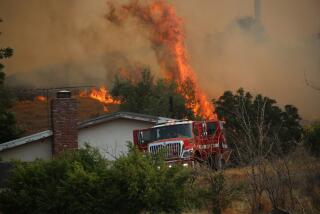FDIC Says Costs From Bank Crisis to Top $4 Billion : Banks: Profitability also fell sharply in the third quarter. Fourth-quarter declines are expected as the recession spreads and real estate loans go bad.
- Share via
WASHINGTON — The nation’s worsening banking crisis is taking a heavier than expected toll on the government’s deposit insurance fund this year, with losses soaring to an estimated $4 billion, the Federal Deposit Insurance Corp. reported Tuesday.
FDIC Chairman L. William Seidman said Tuesday that his agency’s estimate of the deposit insurance fund’s 1990 losses because of bank failures has increased 33% in just the past three months.
The bank insurance fund will end the year with slightly more than $9 billion in reserves to back $2 trillion in deposits, he added.
Seidman’s comments at a press conference came as the FDIC reported that the nation’s commercial banks suffered a 29% decline in profitability during the third quarter, as bad real estate loans continued to drag down the balance sheets at many institutions, especially in the Northeast. Net income for the nation’s banks totaled $3.8 billion during the period, down from $5.4 billion during the second quarter.
Seidman warned that fourth-quarter figures for the banking industry will also be bleak, especially as the recession spreads and more real estate loans turn sour. Banks in the West, including California, however, are still outperforming those in other regions of the country, the FDIC said.
In the third quarter, 17.2% of all banks in the West were losing money, but 58.9% of the region’s institutions reported higher profits than in the previous quarter.
Seidman’s grim new figures on deposit insurance follow a far more optimistic forecast that he made at the beginning of the year, when the fund had roughly $13 billion on hand. At that time, Seidman predicted that the fund would break even in 1990 and end the year with $13 billion still in reserve.
But the latest estimate means that the FDIC has seen roughly half of its insurance fund disappear in the past three years; the fund ended 1987 with more than $18 billion on hand.
With losses mounting, Seidman warned that the FDIC and the Bush Administration may seek congressional approval early next year for a plan to bolster the deposit insurance system and increase confidence in the banking system, which is now under greater pressure than at any time since the 1930s.
As part of a radical plan to overhaul the nation’s banking system set to be unveiled in January, Seidman said the Treasury Department is studying whether to force the nation’s banks to provide new financing to infuse cash into the insurance fund. But Seidman insisted that the Bush Administration proposal will not include a request for more taxpayer money for deposit insurance.
“We need a recapitalization plan as soon as possible,” Seidman said. The solvency of the fund is not in question, he stressed. But he added that “it’s increasingly clear that the fund should have a recapitalization plan in place if it is needed. The banks will have to come up with more money. But this won’t cost the taxpayers anything.”
Seidman didn’t detail just how banks would be asked to provide extra financing, and FDIC officials acknowledged that the agency is still studying whether the nation’s increasingly fragile banks can afford to pay more to bolster the insurance system.
Separately, the Bush Administration and the FDIC are also examining a proposal that would require weaker banks to pay higher premiums for deposit insurance than would healthy banks. Currently, deposit insurance premiums are not adjusted to take into account the fact that the government runs a higher risk by insuring deposits at poorly managed banks than it does by backing deposits at financially stable institutions.
On Tuesday, the FDIC’s board received a new recommendation from the agency’s staff that calls on the Bush Administration to introduce such “risk-based” premiums as part of its banking reform package.
That Administration package will encompass a broad range of highly controversial proposals, including one that would give regulators more flexibility to let big banks fail when they get into trouble, rather than prop them up as the government has done in the past. That would represent a dramatic change in federal policy and would, in effect, bring to an end the government’s past practice of covering all of the deposits in failed institutions, even more than the $100,000 coverage per account.
In addition, the Bush Administration may seek to restrict insurance coverage to three accounts per individual depositor, to cut back on the government’s exposure when it is forced to liquidate weak banks. But the plan could go beyond a reform of deposit insurance and also call for full, interstate banking as well as the repeal of the Depression-era prohibition against bank involvement in securities trading.
The Administration is pushing for such a radical overhaul of the financial system because it believes that Washington can no longer ignore the threat the banking crisis poses to the national economy.
So far in 1990, 134 commercial banks have failed, including 35 in the third quarter alone. And now, the FDIC has more than 1,000 other banks on its “problem list” of institutions that are weak and may eventually require a government bailout.
Yet, Seidman still sought to avoid comparisons between the problems facing commercial banks and the debacle in the savings and loan industry, which will require a government bailout that could cost taxpayers as much as $500 billion over the next 40 years.
BANK EARNINGS
Quarterly net income of FDIC insured commercial banks in billions; figures below zero are losses. 1989, 3rd: $0.7 1989, 4th: $2.1 1990, 1st: $6.3 1990, 2nd: $5.4 1990, 3rd: $3.8
Source: FDIC
More to Read
Inside the business of entertainment
The Wide Shot brings you news, analysis and insights on everything from streaming wars to production — and what it all means for the future.
You may occasionally receive promotional content from the Los Angeles Times.









